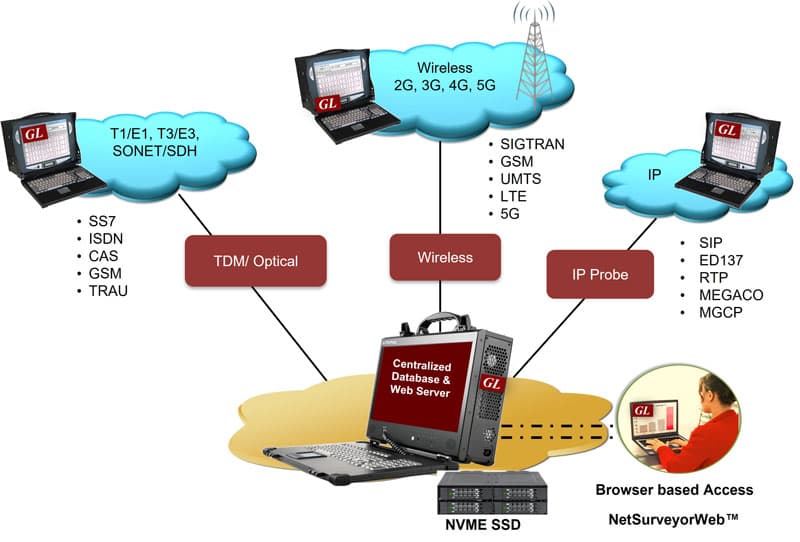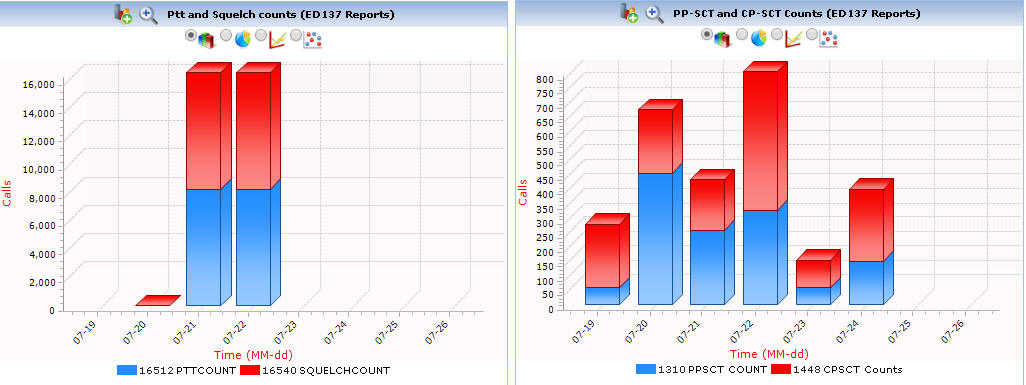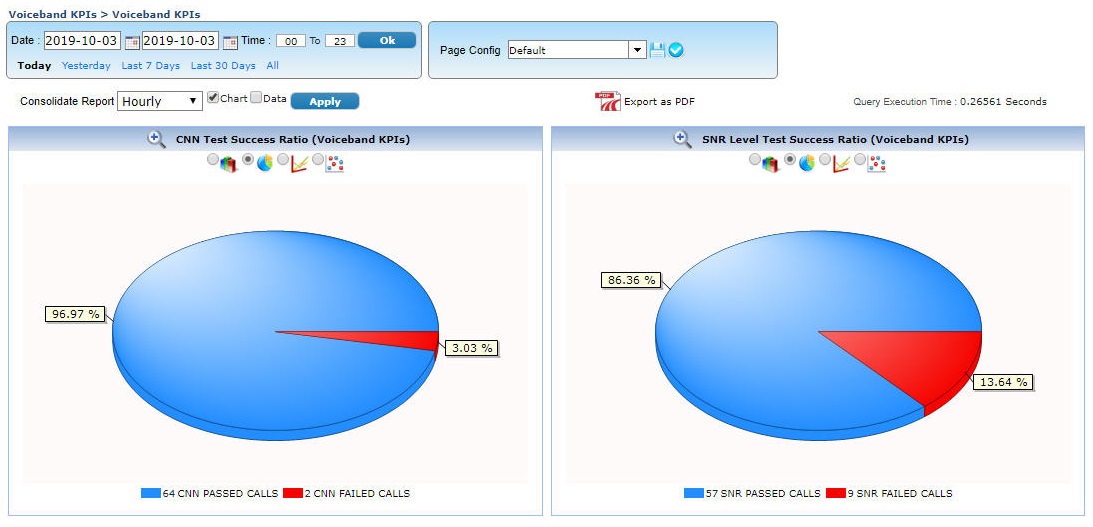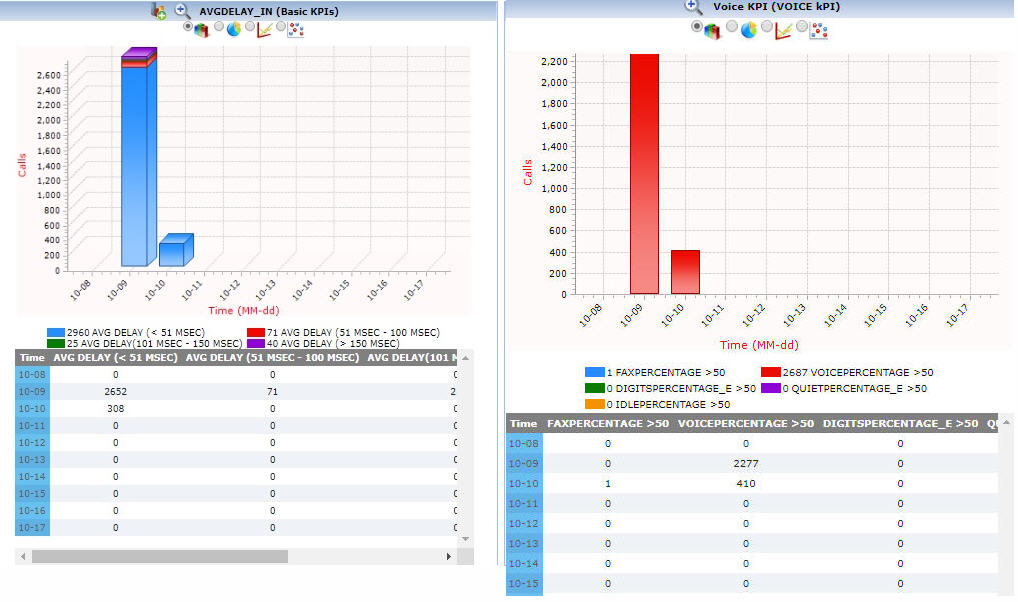Centralized Network Surveillance System for IP, Wireless and TDM Networks
Welcome to the latest issue of GL's Newsletter providing information and insight into our network monitoring and surveillance system (NetSurveyorWeb™) for IP, Wireless and TDM Networks.

Overview
GL's Network Surveillance System can record and playback phone calls and filter on calls of interest. The surveillance system can store, retrieve, query, report, and display Call Detail Records (CDRs) by non-intrusively connecting to TDM, Analog, Optical, or IP networks. Currently supported protocols include 5G, 4G (LTE, IMS, Diameter), 3G UMTS (IuCS, IuPS), 2G (GSM, TRAU, MAP, CAMEL), VoIP (SIP, ED-137, SIGTRAN, H.323, MEGACO, MGCP), TDM (SS7, ISDN, CAS, GSM, TRAU) and Analog systems.
This surveillance system requires protocol analysis probes deployed at various physical locations. These probes capture, decode, and group the traffic into calls and forwards the CDRs, signaling frame details, and other statistics to the centralized database server. These probes can capture data at high speed, store locally, and include protocol analysis software for easy analysis in the field as well.
The central system comprises of a database engine, web server, and NetSurveyorWeb™, a web-based application, to facilitate data storage and retrieval through web browser clients. For customers with low storage requirements, GL offers NetSurveyorWeb™ Lite, which can be deployed on the same system as the network monitoring probes and offers historical data retention up to 9 GB.
Key Features
Quick CDRs - Users can create their own Quick View groups and add the required columns in the created group to be displayed on the Data View.
Whitelisted Calls
Users can whitelist certain calls based on phone numbers and other parameters.
Degraded Calls
Users can categorize the calls based on voice quality parameters.
Long Duration or Short Duration Calls
Users can display calls based on duration.
Failed Calls
Users can categorize calls based on different call failure scenarios.
Monitoring Air Traffic (ED137) Network
Supports Air Traffic Network (ED137) monitoring. This provides CDRs of air-to-ground calls and ground-to-ground calls with improved processing and response times for calculating statistics such as counters for Push-To-Talk (PTT), Squelch, PTTs, PTT Mute, PPSCT Counts. It also provides Quality of Service for each PTT/Squelch session.
Download Call Trace
Download the selected Call Trace either in HDL (GL's proprietary format) or Wireshark® format.
CDR for Analog Phone System
Provides CDR and Key Performance Indicators for Voiceband measurement tests – C-Notched Noise Test, Signal-to-Noise Ratio and Level, Voice Quality Test (VQT POLQA) and Three Tone Slope (Gain Slope).
Voice Quality and Delay Measurement Metrics
NetSurveyorWeb™ application works with Voice Band Analyzer (VBA) application to analyze voice band traffic and provide useful metrics to service providers - Active Speech Level, Noise Level, Speech Activity Factor, Power Measurements, Clipped Samples, DC Level.
It also works with Delay Measurement tools to analyze captured voice traffic and provide precise one-way delay metrics.
Other Features Includes:
- Ability to support various decode standards such as ANSI, ITU, ETSI, 3GPP, for all the supported protocols
- Call Detail Records
- Display real-time data signaling, traffic and Quality of Service performance metrics
- Ability to export both Call Graph and Decode view PDF and HTML file formats with an option to send Email with the exported file format
- Search and filter calls of interest
- Drill-down to calls of interest with customized filter and/or search options
- Apply single or complex filters for data analysis
- Key Performance Indicators
- Packet loss, Gap, Jitter, Delay, RTP Performance Statistics, R-factor and MOS Scores, and Unparalleled Voice Band Statistics
- Signaling messages and Traffic Types; Successful and Unsuccessful failure causes
- Graphs and Reports Generation
- Ability to export both graphical and tabular reports as PDF and HTML file formats with an option to send Email with the exported file format
- Customized graphs for various metrics such as Call Completion Ratio, Answer Call Ratio, Answer-Seizure Ratio (ASR), and Call Duration







 Back to Newsletter Index Page
Back to Newsletter Index Page